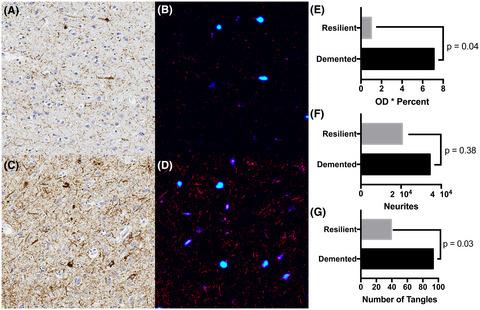当前位置:
X-MOL 学术
›
Brain Pathol.
›
论文详情
Our official English website, www.x-mol.net, welcomes your
feedback! (Note: you will need to create a separate account there.)
Application of deep learning to understand resilience to Alzheimer's disease pathology
Brain Pathology ( IF 5.8 ) Pub Date : 2021-05-19 , DOI: 10.1111/bpa.12974 Cecilia S Lee 1 , Caitlin S Latimer 2 , Jonathan C Henriksen 2 , Marian Blazes 1 , Eric B Larson 3 , Paul K Crane 4 , C Dirk Keene 2 , Aaron Y Lee 1
Brain Pathology ( IF 5.8 ) Pub Date : 2021-05-19 , DOI: 10.1111/bpa.12974 Cecilia S Lee 1 , Caitlin S Latimer 2 , Jonathan C Henriksen 2 , Marian Blazes 1 , Eric B Larson 3 , Paul K Crane 4 , C Dirk Keene 2 , Aaron Y Lee 1
Affiliation

|
People who have Alzheimer's disease neuropathologic change (ADNC) typically associated with dementia but not the associated cognitive decline can be considered to be “resilient” to the effects of ADNC. We have previously reported lower neocortical levels of hyperphosphorylated tau (pTau) and less limbic-predominant age-related TDP-43 encephalopathy neuropathologic change (LATE-NC) in the resilient participants compared to those with dementia and similar ADNC as determined by current NIA-AA recommendations using traditional semi-quantitative assessments of amyloid β and pathological tau burden. To better understand differences between AD-dementia and resilient participants, we developed and applied a deep learning approach to analyze the neuropathology of 14 brain donors from the Adult Changes in Thought study, including seven stringently defined resilient participants and seven age-matched AD-dementia controls. We created two novel, fully automated deep learning algorithms to quantify the level of phosphorylated TDP-43 (pTDP-43) and pTau in whole slide imaging. The models performed better than traditional techniques for quantifying pTDP-43 and pTau. The second model was able to segment lesions staining for pTau into neurofibrillary tangles (NFTs) and tau neurites (neuronal processes positive for pTau). Both groups had similar quantities of pTau localizing to neurites, but the pTau burden associated with NFTs in the resilient group was significantly lower compared to the group with dementia. These results validate use of deep learning approaches to quantify clinically relevant microscopic characteristics from neuropathology workups. These results also suggest that the burden of NFTs is more strongly associated with cognitive impairment than the more diffuse neuritic tau commonly seen with tangle pathology and suggest that additional factors may underlie resilience mechanisms defined by traditional means.
中文翻译:

应用深度学习来理解阿尔茨海默病病理学的复原力
患有阿尔茨海默病神经病理学改变 (ADNC) 的人通常与痴呆相关,但与认知能力下降无关,可以被认为对 ADNC 的影响具有“弹性”。我们之前曾报道,与痴呆症和类似 ADNC 的患者相比,根据当前 NIA- AA 建议使用淀粉样蛋白 β 和病理性 tau 负荷的传统半定量评估。为了更好地了解 AD 痴呆症和有复原力的参与者之间的差异,我们开发并应用了一种深度学习方法来分析来自成人思想变化研究的 14 名脑供体的神经病理学,包括七个严格定义的弹性参与者和七个年龄匹配的 AD 痴呆症控制。我们创建了两种新颖的全自动深度学习算法来量化整个载玻片成像中磷酸化 TDP-43 (pTDP-43) 和 pTau 的水平。这些模型在量化 pTDP-43 和 pTau 方面的表现优于传统技术。第二个模型能够将 pTau 染色的病变分割成神经原纤维缠结 (NFT) 和 tau 神经突(对 pTau 呈阳性的神经元突起)。两组的 pTau 定位于神经突的数量相似,但与痴呆组相比,弹性组中与 NFT 相关的 pTau 负担显着降低。这些结果验证了使用深度学习方法从神经病理学检查中量化临床相关的微观特征。
更新日期:2021-05-19
中文翻译:

应用深度学习来理解阿尔茨海默病病理学的复原力
患有阿尔茨海默病神经病理学改变 (ADNC) 的人通常与痴呆相关,但与认知能力下降无关,可以被认为对 ADNC 的影响具有“弹性”。我们之前曾报道,与痴呆症和类似 ADNC 的患者相比,根据当前 NIA- AA 建议使用淀粉样蛋白 β 和病理性 tau 负荷的传统半定量评估。为了更好地了解 AD 痴呆症和有复原力的参与者之间的差异,我们开发并应用了一种深度学习方法来分析来自成人思想变化研究的 14 名脑供体的神经病理学,包括七个严格定义的弹性参与者和七个年龄匹配的 AD 痴呆症控制。我们创建了两种新颖的全自动深度学习算法来量化整个载玻片成像中磷酸化 TDP-43 (pTDP-43) 和 pTau 的水平。这些模型在量化 pTDP-43 和 pTau 方面的表现优于传统技术。第二个模型能够将 pTau 染色的病变分割成神经原纤维缠结 (NFT) 和 tau 神经突(对 pTau 呈阳性的神经元突起)。两组的 pTau 定位于神经突的数量相似,但与痴呆组相比,弹性组中与 NFT 相关的 pTau 负担显着降低。这些结果验证了使用深度学习方法从神经病理学检查中量化临床相关的微观特征。











































 京公网安备 11010802027423号
京公网安备 11010802027423号